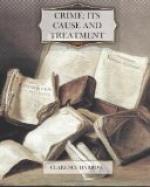Beauty, appeal of, to man’s emotional side,
55.
Bible, vengeance as purpose of punishment shown by,
13-14.
Boys, development of criminals from, 58-64, 75-80;
sex crimes among, 90-91;
and the automobile lure, 210-211.
Buckle, H. T., “History of Civilization,”
cited, 102-103.
Burglar, development of a, 58-60, 62, 92-93.
Burglary, crime of, 92-93.
Capital punishment, question of, 166-171.
Chance, man as subject to element of, 255-262.
Children, as criminals, 75-80;
sex crimes among, 90;
rights of property unknown to, 107.
Christianity, Pliny’s correspondence with Trajan
regarding, 225-228.
Christians, belief of early, in punishment as vengeance,
14-19.
Cities, relative prevalence of crime in, 75-79, 207-208;
crimes against property in, 99.
Civilization, limitations built up around heredity
by, 42-43;
growth of crime coincident with growth
of, 203-211;
the road to decay, 211-212;
does not mean the humanizing of men, 228-229;
new evils and new complexities with each
new, 229.
Confidence game in obtaining property, law against,
137.
Conscience, as a guide to conduct, 4-5, 109.
Conspiracy, statute concerning, 136-137.
Convicts, in prison and after 120-123, 230-232;
good found in, 181.
Courts, growth in number and kind of, 139.
Crime, defined, 1-11;
purpose of punishment of, 12-27;
failure of punishment as a deterrent from,
21-24;
need for better understanding of, by the
public, 27;
responsibility for, 28-36;
part played by heredity and environment
in, 36;
among women, 71-74;
of homicide, 81-87;
due to sex relations, 88-91;
of robbery and burglary, 92-93;
performed against property, 101-108;
question of increase in, 134-142;
industrialism and, 203-208;
increase of, due to the automobile, 208-211;
war and, 213-220;
disease, accident, and, 250-254;
elements of luck and chance as related
to, 255-262;
remedies for, 273-285.
Criminal, scope of word, 1-6;
one who violates “folk-ways”
of his community, 6-9;
purpose of punishment of the, 12-27;
need for better understanding of, 27;
reasons for existence of, 56-70;
the female, 71-74;
the juvenile, 75-80;
attitude of the, 109-115;
the law and the, 116-129;
effect on others of punishment of, 158-160;
stigmata of, 172-177;
the good in the, 178-182;
pardon, parole, and placing on probation
of, 263-272.
Criminal conduct, psychology of, 44-55.
Dante, the hell of, 15.
Death penalty, methods of inflicting, 163.
Defectives, discussion of the, 183 ff.;
in prisons, 184-185;
proposed isolation or sterilization of,
233-249.
Disease, treatment of crime contrasted with that of,
139-140, 154,
230-232;
crime, accidents, and, 250-253.
Doctors, employment of, in trials, as experts, 143-149.
Dugdale, R.L., study of “The Jukes” by,
244-248.




